#charles de noailles
Text
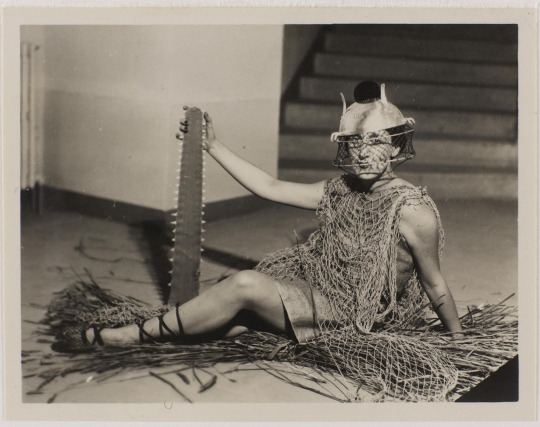
Man Ray (Emmanuel Radnitzky) :: Bal au château des Noailles, vers 1929. [full image] | src l'œil de la photographie
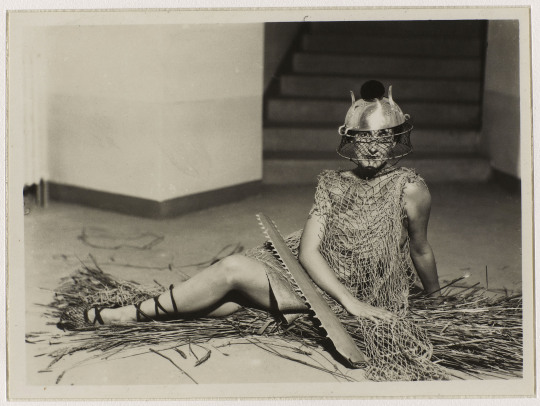
Man Ray (Emmanuel Radnitzky) :: Bal au château des Noailles, vers 1929. Epreuve gélatino-argentique. | src Centre Pompidou
view more on wordPress
#man ray#emmanuel radnitzky#portrait#role portrait#ball costume#bal costumé#bal costume#chateau de noailles#charles de noailles#disguise#surrealism#surrealisme#1920s
87 notes
·
View notes
Quote
To Marie-Laure and Charles de Noailles
Paris, 17 March 1932
Very dear friends,
I’ve been wanting to write to you for some time now – since receiving Charles’s letter – but these last few days I’ve been very busy with endless surrealist complications. I’m also tied up with ‘dubbing’ work for Paramount.
I spoke to Giacometti the other day about the surprise Charles mentioned in his letter: he has agreed to prepare it with me and we’ll keep you informed. As for Crevel, he told me he would write to you. He came for supper at my home on Sunday, with Mrs Cuevas and Ortiz.
Naturally, we spoke of nothing all night but the latest complications with the group. For rather complicated reasons, a new splinter group has formed consisting this time of Aragon, Sadoul, Unik, Alexandre, Giacometti and me. This split was caused by the publication of Breton’s Poetry’s Misery. Dalí wrote to me from Cadaqués: he now represents the extreme right wing of surrealism. It’s all so sad and you can imagine the terrible time we are having.
Frankly, the Marseille business did not go well. That Mr Castelli took two months to decide to pay me 2,000 francs, and I see from your letter that the takings came to 13,000. The same with Belgium and Holland. As they don’t want to pay me more than 1,000 francs per screening, I’ve spent the last month writing to them. Everyone has the same excuse: limited screenings due to censorship. I should like to know what you think, and whether you would prefer I just keep the film with me here, rather than let it go at that price. I still think that had the censors not intervened we would have recovered the production costs; Braunberger was saying the same thing a few days ago. The film has also been requested by Prague.
If you have a moment to write, I’d be grateful for more specific details about the kind of surprise you would like so that we can get on with our preparation. It goes without saying that we’ll try to do the best possible job.
The other evening after dinner we played some poetic games and René was lamenting that Marie-Laure was not with us, because she would have loved it. Mrs Cuevas was truly inspired and wanted to carry on and wash the dishes. Only a titanic struggle on our part dissuaded her.
There are no major novelties as far as films go. There was a magnificent Eddie Cantor film, Palmy Days. Renoir’s film The Bitch, is very well made and has a very good cast. In my opinion, it’s the best French film in recent years. I went to see Orpheus by Offenbach and found it admirable. A play, Pains of Youth, has caused great commotion among the surrealists, especially Breton; but I prefer Wedekind. It’s the same genre, of course, but with that unpleasant so-called ‘post-war’ touch. Wedekind filtered through the Treaty of Versaille.
I got Nora’s letter and want to write back at once. Do let her know and send her my thanks in advance.
Love to Laure and Nathalie and all my friendship to you both,
Luis
Jo Evans & Breixo Viejo, Luis Buñuel: A Life in Letters
#jo evans#breixo viejo#luis bunuel: a life in letters#luis bunuel#charles de noailles#salvador dali#a. edward sutherland#jean renoir#jacques offenbach#ferdinand bruckner#frank wedekind
2 notes
·
View notes
Text
Hamilton vs. History
As most people are certainly aware of, Hamilton: An American Musical is not an exact representation of history and never wanted to be one. But when a pop-culture medium is so widespread and in certain places almost as omnipresent as Hamilton is, there will always be a blend between fact and fiction. Certain aspects of fiction or pop-culture simply make such a strong impression on us, that they shape our view on reality/history. Some aspects appear so much more fun, so much brighter in fiction, that we often do not want to know weather said aspect really happened this way. Some other details are so minor, that they are hard to catch if you are not deeply interested in the topic at hand.
Since I do know a thing or two about La Fayette, I thought I take a little deep dive into his depiction in Hamilton.
As a little disclaimer, while I have read the book Hamilton by Ron Chernow and listened to the official cast recording, I have never seen an actual production and can therefore not take into account what the actors do on stage.
Appearance:
I would have hoped that I do not have to say it, but I have made the experience in the past that I indeed do have so say it; La Fayette was not dark skinned. He was as white as the rest of influential America and Europa at that time.
As to his costume, well, he wears two uniforms throughout the play (plus the white suit at the beginning and in the end and his civilian clothes at the beginning of Act I)

His first uniform is identical with Mulligan’s, Laurens’ and Hamilton’s uniform – not quite right since he was a Major-General and the others were not. A more suitable uniform would have looked something like this:
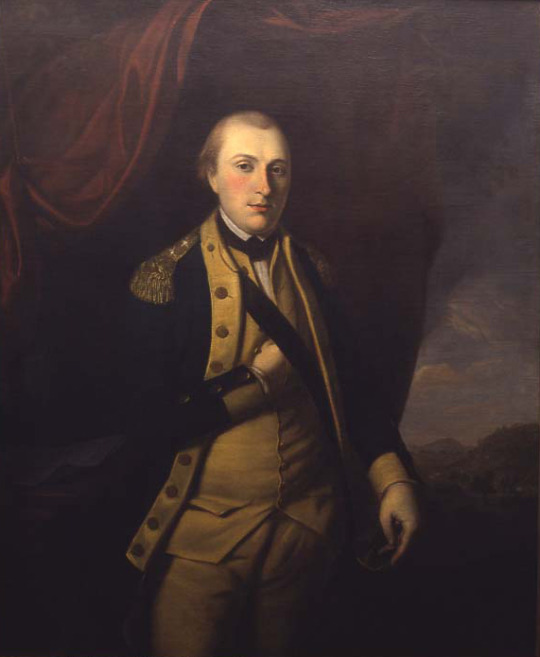
The second, and probably more prominent uniform, is this one:
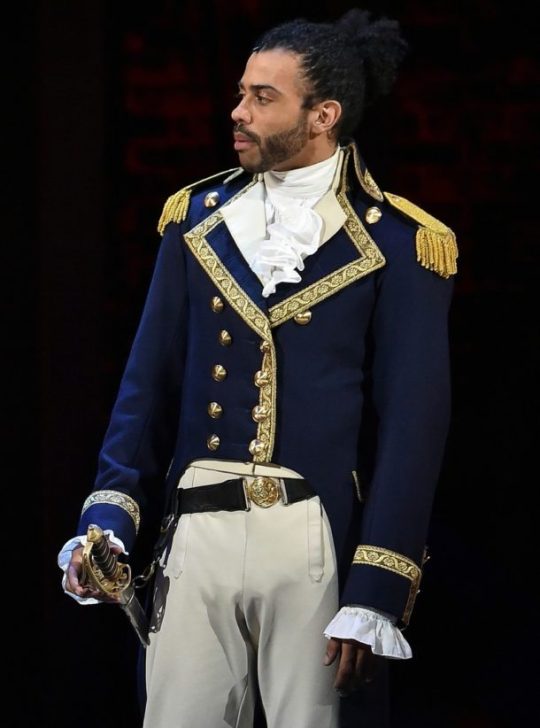
La Fayette wore this uniform as a lieutenant general in 1791 towards the end of his military service during the French Revolution, so roughly a decade later, in a different country during a different revolution.

Aaron Burr, Sir
With this song we are introduced to La Fayette for the first time. As a disclaimer, La Fayette never met Hercules Mulligan, had very little contact with Aaron Burr and he also met Hamilton and Laurens at the same time.
[LAFAYETTE]
Oui oui, mon ami, je m'appelle Lafayette!
The Lancelot of the revolutionary set!
I came from afar just to say “Bonsoir!”
Tell the King “Casse toi!” Who's the best?
C'est moi!
I like that La Fayette is speaking French in his opening lyrics because by the time of his arrival in America he only had a very limited knowledge of the English language and he needed a few extra months to feel entirely comfortable. Hamilton and Laurens both spoke French and this circumstance really helped in building their friendship.
La Fayette also makes a remark regarding the legendary (often described as French) knight Lancelot du Lac. Quite fitting, given that La Fayette hailed from a line of literally knights and these were stories and (self-)characterisations that he was quite attached to.
Other than that, the song is a bit too bubbly for my taste. Yes, La Fayette could be extremely energetic and optimistic, but he could also be incredibly self-conscious. He knew that he had no practical knowledge, that he barely understood the language, that his age was working against him, he even told Washington that he came to learn and not to teach – he would have never said “Who’s the best? C’est moi!” And while we are at it, he also did not like swearing.
My Shot
[LAFAYETTE]
I dream of life without a monarchy
The unrest in France will lead to 'onarchy?
'Onarchy? How you say, how you s-oh, 'anarchy!'
When I fight, I make the other side panicky
With my—
I suspect that the first line is directed towards the French monarchy, since France was where the vast majority of his life took place. If so – no, La Fayette did not dream of life without a monarchy. Later, during the French Revolution he was critical of the monarchy but never wanted to abolish it. He was not called a Counter-Revolutionary and Royalist by his enemies for no reason.
While yes, there had been unrests long before the French Revolution, as we know it, started, these problems were at this time of his life not on La Fayette’s mind.
As to making the other side “panicky”, well, La Fayette had no practically military experience at this point so there were very few people whom he made “panicky” (and I think half of them were members of the Continental Congress and Continental Army.)
But once again, I like La Fayette’s struggle with the English language.
The Story of Tonight
[LAFAYETTE/MULLIGANS/LAURENS]
I may not live to see our glory!
This line is rather interesting because while, yes, many of La Fayette’s ancestors have died young, his own father among them, and while La Fayette himself had been wounded early on in the Battle of Brandywine and also had been severely ill several times, he wrote these lines to his Adrienne on January 6, 1777 in regards to the birth of their second daughter Anastasie:
For the rest, if one must worry about the family name, I declare that I have decided to live long enough to bear it myself for many years, before I am obliged to bequeath it to another being.
Idzerda Stanley J. et al., editors, Lafayette in the Age of the American Revolution: Selected Letters and Papers, 1776–1790, Volume 1, December 7, 1776–March 30, 1778, Cornell University Press, 1977, p. 222-226.
He certainly was full of optimism to see their glory.
[LAFAYETTE]
Let's have another round tonight!
La Fayette was definitely not averse to a drink or two or fife with his friends. This line is very much in character.
The Story of Tonight (Reprise)
I would like to preface this song by saying that neither La Fayette, nor Laurens, nor Mulligan nor Burr were present at Hamilton’s wedding. The only guest on Hamilton’s side of the wedding party was Doctor James McHenry, former aide-de-camp to Washington and now an aide-de-camp to La Fayette
[LAFAYETTE]
Let's have another round tonight!
As I said previously, this is definitely something that La Fayette would have said. :-)
[LAFAYETTE]
You are the worst, Burr!
There is no reason to believe that La Fayette, even when a bit tipsy, had any ill feelings towards Burr. In fact, La Fayette had very few feelings towards Burr because he mentions the good Sir almost never. There are six letters in total, both to and from La Fayette, that mention Burr and the earliest is from 1807.
Stay Alive
[LAFAYETTE]
I ask for French aid, I pray that France has sent a ship
La Fayette lobbied extensively for the American cause, even before his first voyage home again to France.
[WASHINGTON]
Have Lafayette take the lead!
(…)
[LAFAYETTE]
As we snatch a stalemate from the jaws of defeat
The Battle of Monmouth was a wild. Washington offered the command to Lee, who was not interested so Washington went to La Fayette, who gladly accepted the command. Suddenly, Lee’s interest was renewed, and he took command after all. The battle itself was disaster but La Fayette never officially took command but instead worked with Lee to try and safe the day and he was also in command of his own little sub-division.
Guns and Ships
La Fayette's most prominent number in the musical.
[LAFAYETTE]
I’m takin this horse by the reins makin’
Redcoats redder with bloodstains
(…)
[LAFAYETTE]
And I’m never gonna stop until I make ‘em
Drop and burn ‘em up and scatter their remains, I’m
[COMPANY]
Lafayette!
[LAFAYETTE]
Watch me engagin’ em! Escapin’ em!
Enragin’ em! I’m—
(…)
[LAFAYETTE]
I go to France for more funds
(…)
[LAFAYETTE]
I come back with more
[LAFAYETTE AND ENSEMBLE]
Guns
And ships
And so the balance shifts
La Fayette went to France in 1779 and returned to America in 1780. He brought with him the promise of “guns and ships” but the French aide needed some time to arrive.
[LAFAYETTE]
We can end this war at Yorktown, cut them off at sea, but
For this to succeed, there is someone else we need:
(…)
[LAFAYETTE]
Sir, he knows what to do in a trench
Ingenuitive and fluent in French, I mean—
(…)
[LAFAYETTE]
Sir, you’re gonna have to use him eventually
What’s he gonna do on the bench? I mean—
(…)
[LAFAYETTE]
No one has more resilience
Or matches my practical tactical brilliance—
By the time of La Fayette’s return to America, Yorktown was not yet chosen, or better destined, to be the decisive battle in the Revolutionary War, especially since Washington and the French commanders had different ideas about how to proceed.
La Fayette did try to mend Washington’s and Hamilton’s relationship, not only by talking with Washington but also with Hamilton. And no, he would have never said, that he was tactically brilliant – because he was not, simple as that.
Yorktown (the World Turned Upside Down)
[LAFAYETTE]
Monsieur Hamilton
[HAMILTON]
Monsieur Lafayette
[LAFAYETTE]
In command where you belong
[HAMILTON]
How you say, no sweat
We're finally on the field. We’ve had quite a run
[LAFAYETTE]
Immigrants:
[HAMILTON/LAFAYETTE]
We get the job done
This is such a lovely scene, isn’t it? But it never happened like that, quite the opposite actually. La Fayette chose one of his former aide-de-camps, Jean-Joseph Soubadère de Gimat, to take command of the storming of redoubt number 10. Hamilton was eager to be given the command but when La Fayette refused he went straight to Washington who decided in Hamilton’s favour and overruled La Fayette’s decision. While in the end this incident did not harm La Fayette’s and Hamilton’s friendship, La Fayette was anything but happy with the situation.
[HAMILTON]
So what happens if we win?
[LAFAYETTE]
I go back to France
I bring freedom to my people if I’m given the chance
As I have now already mentioned a couple of times, at this time there was not really any freedom that La Fayette wanted to bring to France. There were certainly political and social matters that he was interested in and some laws that he would have liked to see reformed – but I feel like these lines imply a fixed agenda that simply was not there yet.
[HAMILTON]
When we finally drive the British away
Lafayette is there waiting—
[HAMILTON/LAFAYETTE]
In Chesapeake Bay!
La Fayette and his troops played a vital role in cornering and keeping the British troops in Yorktown by making a retreat by land impossible.
[LAFAYETTE]
Freedom for America, freedom for France!
Again, freedom for France was not yet on the forefront of La Fayette’s mind.
Cabinet Battle #2
[Jefferson]
Did you forget Lafayette?
[Hamilton]
What?
[Jefferson]
Have you an ounce of regret?
You accumulate debt, you accumulate power
Yet in their hour of need, you forget
[Hamilton]
Lafayette’s a smart man, he’ll be fine
And before he was your friend, he was mine
If we try to fight in every revolution in the world, we never stop
Where do we draw the line?
La Fayette’s imprisonment was a headache inducing topic for many people at the time. Neither Hamilton, nor Jefferson, nor Washington for that matter, had forgotten La Fayette, but there was very little that could be done from their positions. What could be done however, was done and Hamilton and Jefferson both helped. Interesting is here the change of roles – Jefferson accuses Hamilton of not caring while Hamilton himself is rather optimistic. In reality it was Hamilton who did way more for La Fayette, even taking his son in, while Jefferson, although concerned and helpful, sometimes had a mindset of “Well, it is a revolution, shit happens.”
This post is not intended as a critique of the musical or the people who like it and listen to it, this is simply a little note for the curious. :-)
#marquis de lafayette#la fayette#american history#french history#french revolution#american revolution#alexander hamilton#john laurens#hercules mulligan#aaron burr#adrienne de lafayette#adrienne de noailles#letters#hamilton an american musical#hamilton musical#art#charles lee#george washington#1779#1780#1791#battle of monmouth
95 notes
·
View notes
Text



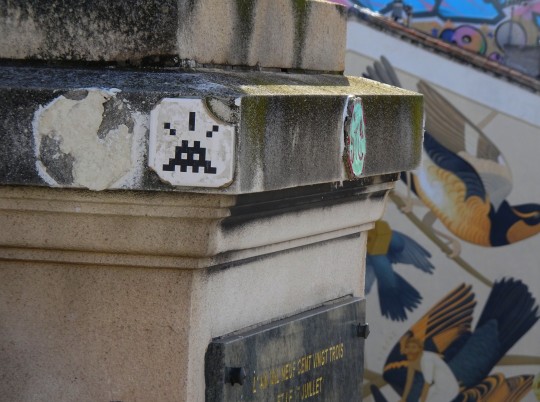

Allez, une série de 5 posts : "Invader à Marseille" ! (si vous en connaissez d'autres, dites-le moi !)
rue des Lices, sur le chemin montant à Notre-Dame de la Garde ; c'est pourquoi la Bonne Mère tient ce petit alien dans ses bras !
entre la rue Moustier et la rue d'Aubagne
entre le Cours Belsunce et la rue du Tapis-Vert
Escaliers de la Gare Saint-Charles (mais ici aussi, j'ai un doute...)
Chemin du Roucas-Blanc
#marseille#invader#notre-dame de la garde#bonne mère#alien#rue d'aubagne#noailles#rue moustier#cours belsunce#rue du tapis-vert#gare saint-charles#chemin du roucas blanc#roucas blanc
3 notes
·
View notes
Text






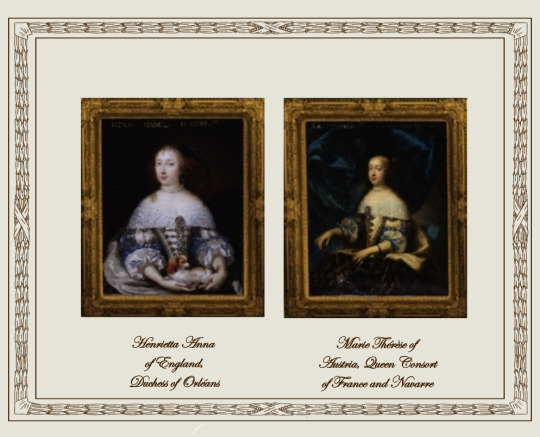
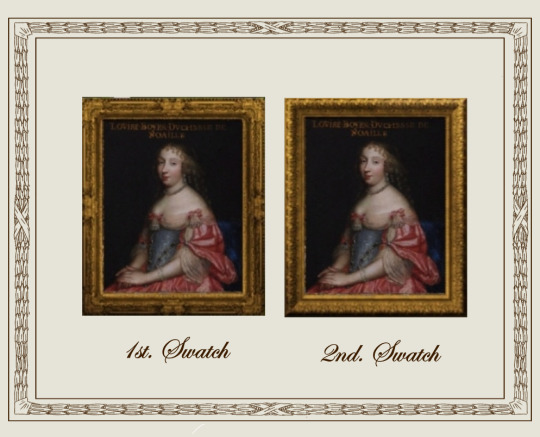
Louis XIV's Gallery of Beauties
A retexture by La Comtesse Zouboff — Original Mesh by @thejim07
This set of 20 portraits was comissioned by the king himself in the 1650s to Charles and Henri Beaubrun (except for a portrait of Henrietta Anna of England, Comissioned to Nicolas Mignard) The portraits comprises the queen, royal princesses and ladies of the court. They hanged at the king's appartments at Versailles. In the 1670s the paintings were progressively relegated to the king's minor residences, but in 1837, Louis-Philippe, King of the French turned Versailles into a museum and rejoined the paintings, in the Louis XIV Rooms, where they remain.
The set includes 20 portraits, with the original frame swatches, fully recolorable. The portraits are of:
Anne Genèvieve de Bourbon, Duchess d'Estouteville and Longueville
Françoise-Athénaïs de Rochechouart (later, Marquise de Montespan)
Anna Martonozzi, Princess of Conti
Anne Louise Boyer, Duchess of Noailles
Anne Marie Gonzaga, Countess Palatine
Anne de Rohan-Chabot, Princess de Soubise
Catherine Henriette d'Harcourt, Duchess d'Arpajon
Catherine de Neuville, Countess d'Armagnac
Charlotte Catherine de Gramont, Proncess of Monaco
Charlotte Isabelle Angélique de Montmorency-Bouteville, Duchess of Mecklenburg-Schwerin
Elizabeth of Orléans, Duchess of Guise and Joÿeuse
Françoise Madeleine d'Orléans (née de Valois) Duchess of Savoy
Françoise Mignot, Mareschalle of l'Hospital
Françoise de Neufville, Duchess of Chaulnes
Gabrielle-Louise de Saint-Simon, Duchess of Brissac
Henrietta Anna of England, Duchess of Orléans
Madeleine-Charlotte d'Albert-d'Ailly, Duchess of Foix
Marguerite Louise d'Orléans, Grand Duchess of Tuscany
Marguerite-Louise-Suzanne de Béthune-Sully, Countess of Gyche
Marie Thérèse of Austria, Queen Consort of France and Navarre
Found under Decor > Paintings for 940 §
Retextured from the "portrait of Anne Marie Louise d'Orléans", found here
Table, torcheres and floor by @thejim07
Rest of the decor by @joojconverts
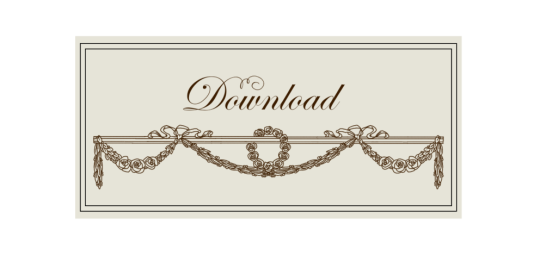
Drive
(Sims3pack | package)
(Useful tags)
@joojconverts @ts3history @ts3historicalccfinds @deniisu-sims @katsujiiccfinds
-------------------------------------------------------
#the sims 3#ts3#sims 3 cc#portrait#s3cc#sims 3#sims 3 download#sims 3 cc finds#palace of versailles#sims 3 decor#wall decor
41 notes
·
View notes
Text
Hi,
I make period drama style gifs for free. If you use gif packs, please like and reblog them. Most of my projects are already ready, but every day I post no more than 190 gifs. Because that was the reason why my previous account was blocked.
I tried to make gif packs in a format more familiar to you with a link to a separate page. However, unfortunately, I did not succeed because of the large format of high-quality gifs.
I want to explain about color processing. Usually, I improve the contrast, brightness and saturation, but leave the naturalness of the film. I don't make the contours too sharp because I like the aesthetic of it looking like a natural image.
Actors in alphabetical order: part 1(A-D), part 2, part 3
Navigation
The arrangement of names may not be alphabetical
▶Page 1
Anne Hathaway
Anya Taylor-Joy
Asia Argento
Astrid Berges-Frisbey
Boran Kuzum
Camille Rutherford
▶Page 2
Carla Juri
César Domboy
Cate Blanchett
Charity Wakefield
Charlie Rowe
Chiara Mastroianni
Christian Bale
Christoph Waltz
Ethan Erickson
▶Page 3
Dagmara Dominczyk
Dan Stevens
Ella Purnell
Emily Blunt
Ezra Miller
Raffey Cassidy
Rebecca Emilie Sattrup
Rose Byrne
Roxane Duran
▶Page 4
Frances O'Connor
Gemma Arterton
Hannah Taylor-Gordon
Hattie Morahan
Hugh Dancy
Isabelle Adjani
▶Page 5
Izzy Meikle-Small
James Norton
Jane Birkin
Joanne Whalley
Lucy Boynton
Léa Seydoux
Monica Keena
Nicolas Duvauchelle
Sally Hawkins
▶Page 6
Adriana Tarábková
Dakota Fanning
Gaia Weiss
Kirsten Dunst
Pia Degermark
Roxane Mesquida
Rosamund Pike
Samantha Gates
Sophia Myles
▶Page 7
Annabelle Wallis
Carey Mulligan
Guy Pearce
James Frain
Olivia Cooke
Rachel Hurd-Wood
Soko
Sujaya Dasgupta
Tom Cruise
▶Page 8
Adèle Exarchopoulos
Anna Maxwell Martin
Charles Dance
Emma Williams
Gillian Anderson
Natalie Press
▶Page 9
María Valverde
Paz Vega
Frédéric Noaille
Catherine Mouchet
Déborah François
Joséphine Japy
▶Page 10
Ben Whishaw
Clémence Poésy
Elliot Grihault
Emilia Fox
Joseph Morgan
Lambert Wilson
Michelle Dockery
Phoebe Fox
Sophie Okonedo
Tom Hiddleston
Tom Hughes
Tom Sturridge
▶Page 11
Charlotte Gainsbourg
Felicity Jones
Fu'ad Aït Aattou
Greta Scacchi
Helena Bonham Carter
Holliday Grainger
Michelle Pfeiffer
Rupert Friend
Christina Giannelli
▶Page 12
Danylo Kolomiiets
Katie McGrath
Keeley Hawes
Maria Bonnevie
Marta Gastini
Miriam Giovanelli
Olivia Hussey
Oscar Isaac
Peter Plaugborg
▶Page 13
Ben Barnes
Ben Chaplin
Bill Skarsgård
Iben Akerlie
Jakob Oftebro
Jo Woodcock
Lily-Rose Depp
Reese Witherspoon
Ruth Wilson
Samantha Soule
Tess Frazer
Virginie Ledoyen
▶Page 14
Cary Elwes
Colin Firth
Daniel Day-Lewis
Emilia Verginelli
Hannah James
Jonah Hauer-King
Loli Bahia
Lorenzo Balducci
Rebecca Hall
Robin Wright
Rupert Everett
Willa Fitzgerald
▶Page 15
Annes Elwy
Claire Danes
Eliza Scanlen
Kathryn Newton
Maya Hawke
Romola Garai
Samantha Mathis
Trini Alvarado
Winona Ryder
▶Page 16
Douglas Smith
Eric Bana
Gizem Karaca
Jessica Brown Findlay
Kenneth Branagh
Millie Brady
Natalie Dormer
Poppy Delevingne
Rachel Weisz
Rosy McEwen
Sam Claflin
▶Page 17
Aubri Ibrag
Christina Hendricks
Connie Jenkins-Greig
Guy Remmers
Henry Cavill
Imogen Waterhouse
Josie Totah
Mia Threapleton
Olivia Hallinan
▶Page 18
Fahriye Evcen
Jim Caviezel
Justine Waddell
Penelope Cruz
▶Page 19
Emma Stone
Francesca Annis
Jasmine Blackborow
Louis Cunningham
Mélanie Thierry
▶Page 20
To do list:
Léa Seydoux - under development (Roses à crédit 2010, Belle Épine 2010, Mistérios de Lisboa 2010, The Beast 2023, Dune: Part Two)
Kelly Macdonald - under development (Elizabeth1998, Nanny McPhee 2005, Harry Potter and the Deathly Hallows Part 2 2011, Boardwalk Empire)
Emily Mortimer - under development (Elizabeth1998, The Glass Virgin 1995, Leonie 2010)
All of these gifs were made from scratch by me for roleplaying purposes. Feel free to use them as sidebars and reaction gifs. PLEASE DON’T CLAIM THEM AS YOUR OWN.

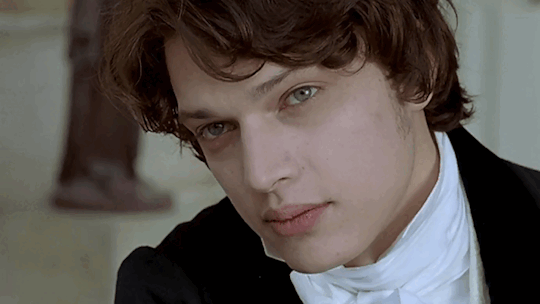

10 notes
·
View notes
Photo

Louis-Marie, Vicomte de Noailles. 1798. Credit line: Purchase, Henry R. Luce Gift, Elihu Root Jr. Bequest, Rogers Fund, Maria DeWitt Jesup Fund, Morris K. Jesup Fund and Charles and Anita Blatt Gift, 1970 https://www.metmuseum.org/art/collection/search/12672
#aesthetic#art#abstract art#art museum#art history#The Metropolitan Museum of Art#museum#museum photography#museum aesthetic#dark academia
4 notes
·
View notes
Text
@lepetitechodesarts
je ne sais pas si tu as vu ce doc sur la 5, très interessant sur la vie des de Noailles, leur passion pour l'art, leur maison à Hyeres que j'ai visité il y a qq années et qui est maintenant dédiée à l'art contemporain (évidemment !!) 2 passionnés d'art
7 notes
·
View notes
Text
Images of 1913 Fashion -
Left 1913 (August) Juliette Rudy in dress by Buzenet, Les Modes, Les Modes - photo by Félix. From les-modes.tumblr.com/page/17 730X1920.
Center 1913 (August) Juliette Rudy in ensemble by Buzenet, Les Modes, Les Modes - photo by Talbot. From les-modes.tumblr.com/page/17; fixed bigger spots & flaws w Pshop 762X1920.
Right 1913 (August) Les Modes Racing ensembles by Drecoll. From les-modes.tumblr.com/image/146257484044; fixed larger spots w Pshop 1269X1920.

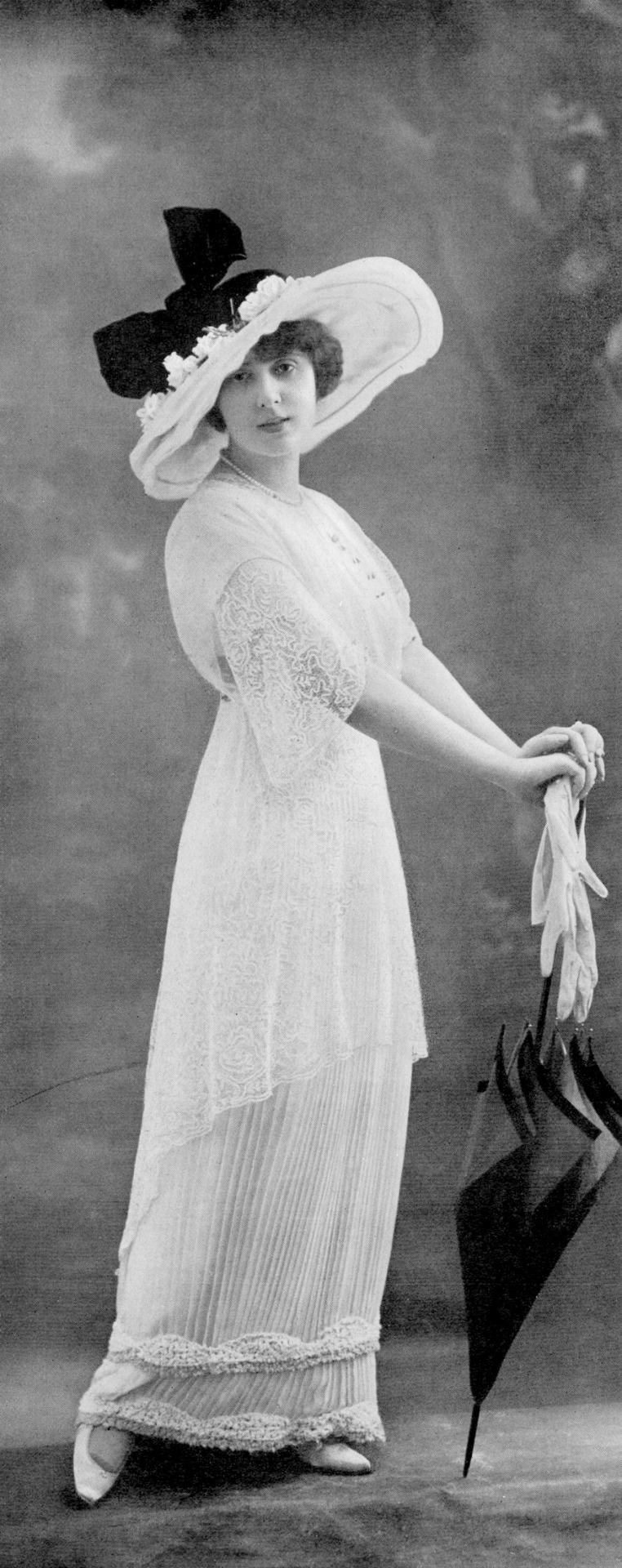

1913 (August) Les Modes Racing ensembles by Drecoll. From les-modes.tumblr.com/image/146257484044; fixed larger spots w Pshop 1269X1920
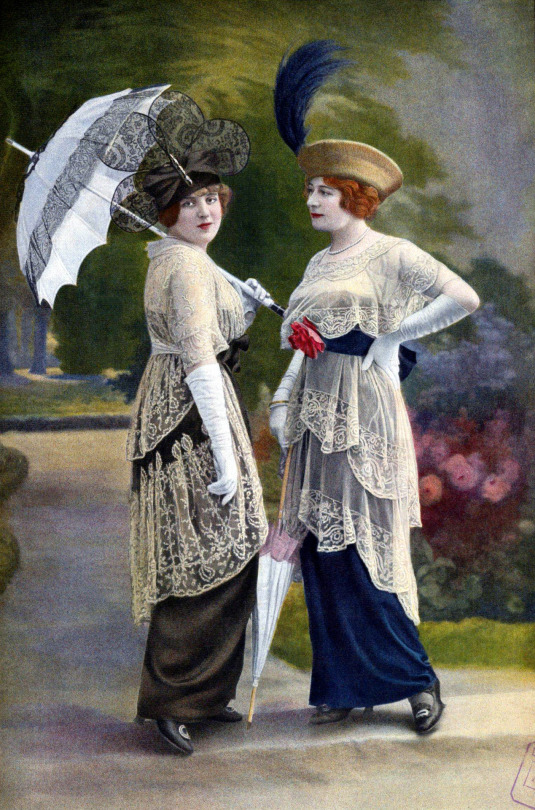
Left 1913 (November) Dress and hat by Jeanne Lanvin, Les Modes - photo by Talbot. From les-modes.tumblr.com/page/10 1280X1882.
Center 1913 (October) Afternoon dress dress by Beer, Les Modes - photo by Félix. From les-modes.tumblr.com/page/9 1024X1920.
Right 1913 (September) Suit by Antoine and Hubert, Les Modes - photo by Félix. From les-modes.tumblr.com/page/10 706X1920.
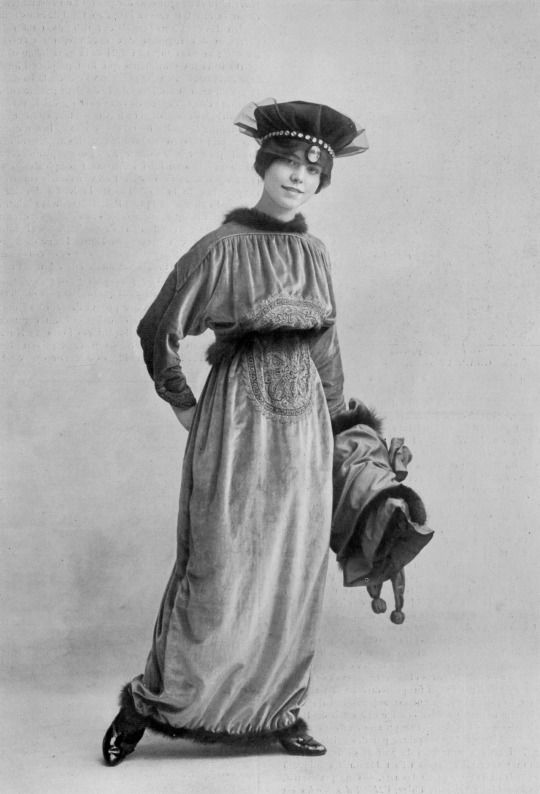

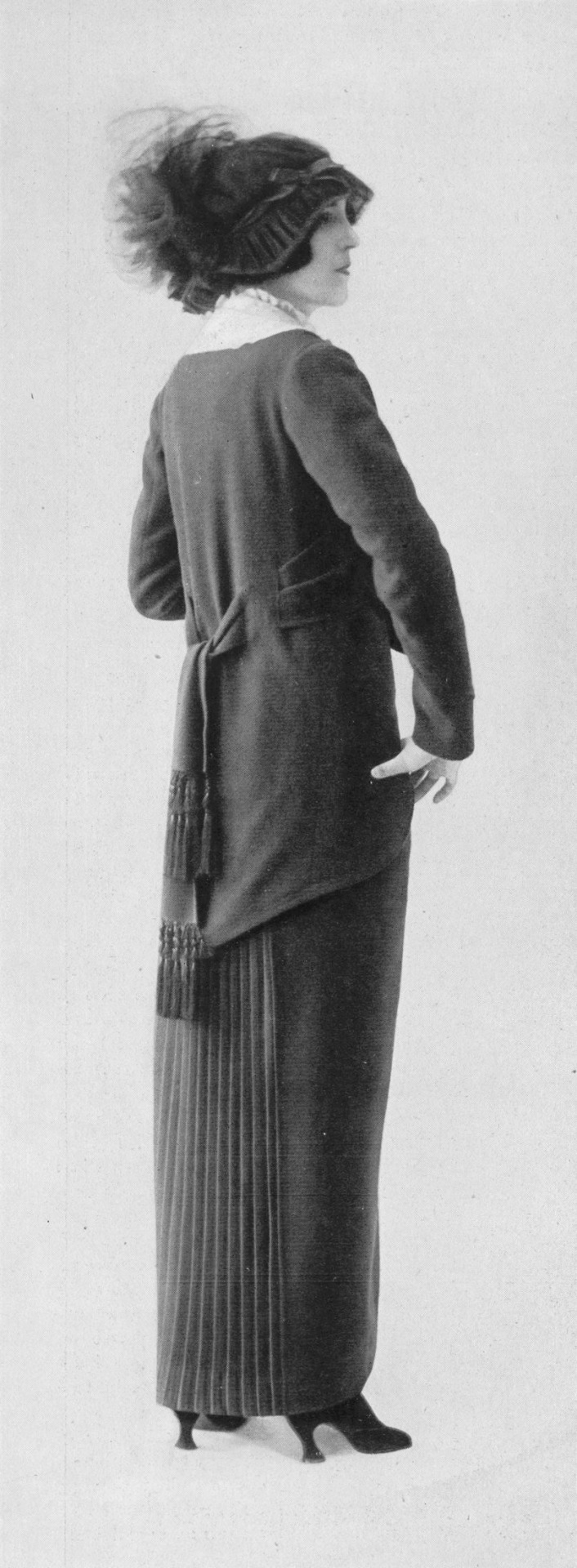
1913 Anne Innes-Ker, Duchess of Roxburghe by Lallie Charles. From Wikimedia 3374X4878.
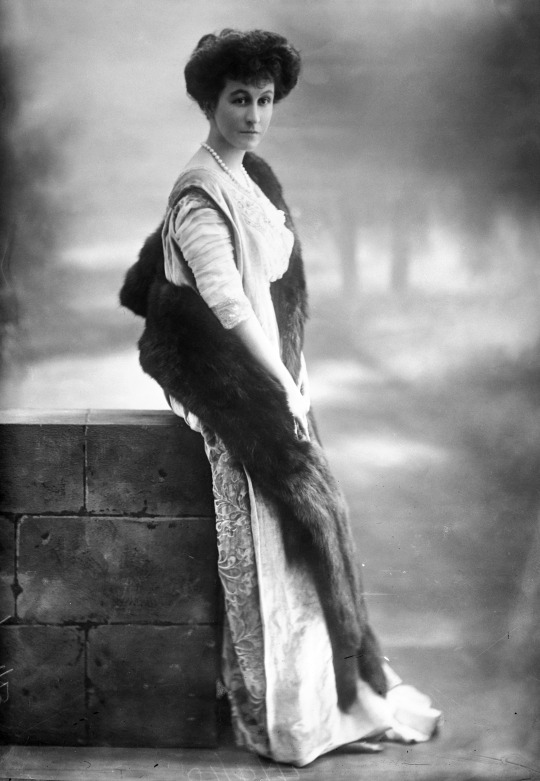
Left 1913 (November) Evening dress by Zimmerman, Les Modes - photo by Félix. From les-modes.tumblr.com/page/10 745X1920.
Right 1913 (October) Evening dress by Beer, Les Modes - photo by Félix. From les-modes.tumblr.com/page/9; fixed bigger spots w Pshop 1280X1890.
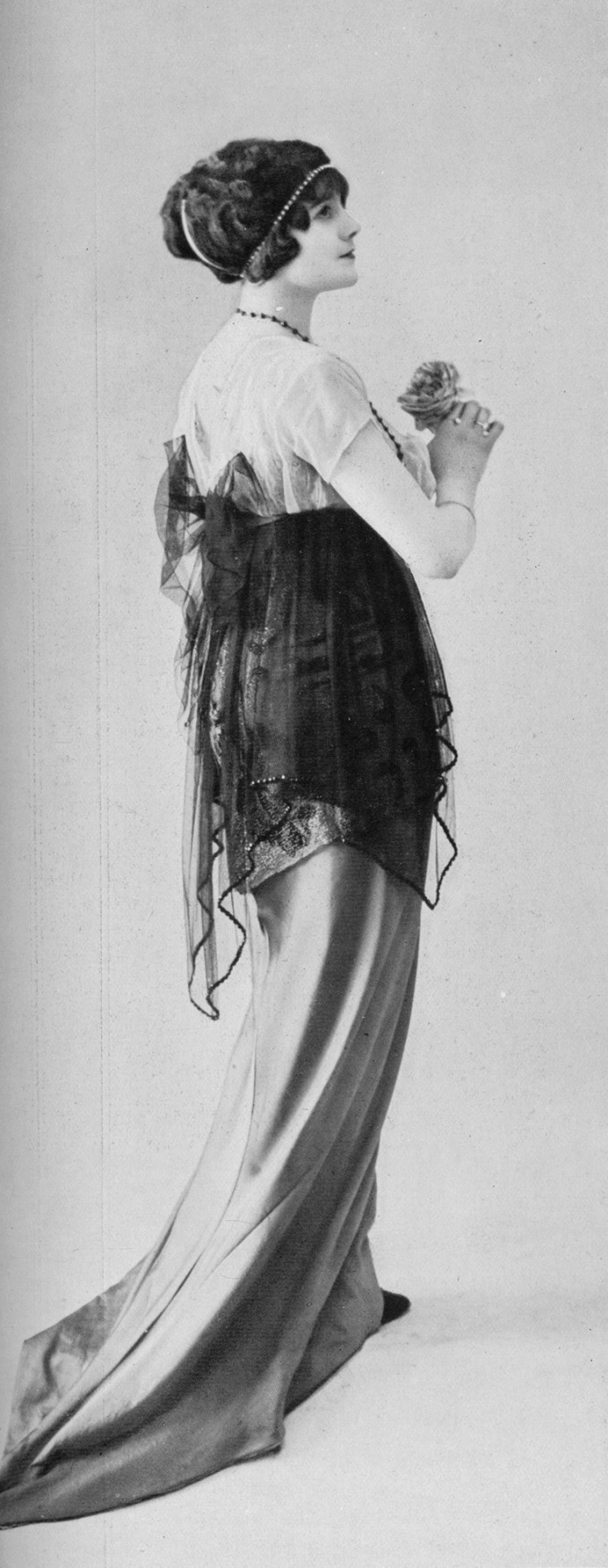

Left 1913 (September) Armand Vallée illustration of Jeanne Lanvin dresses, Les Modes. From les-modes.tumblr.com/page/10 1280X1868.
Right 1913 (February isue) Les Modes Cover - Dress, Mantle and Hair-Ornament by Jeanne Paquin - by Armand Vallée. From tumblr.com/mote-historie/731370297852329984/dress-mantle-and-hair-ornament-by-paquin-1913?source=share& 1961X3000
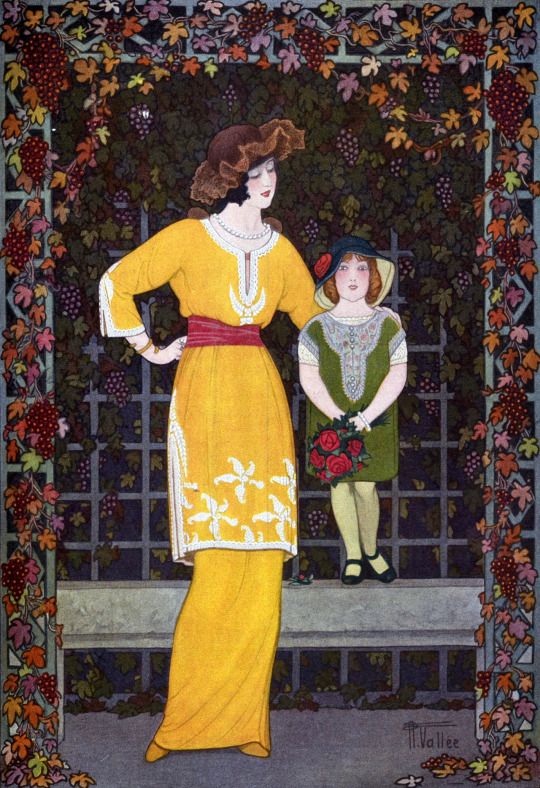

Left 1913 (October) Gaby Deslys in Paquin dress, Les Modes - photo by Talbot. From les-modes.tumblr.com/page/9; fixed biggest spots w Pshop 1280X1891.
Right 1913 (October) Gaby Deslys in Paquin dress and another headdress, Les Modes - photo by Talbot. From les-modes.tumblr.com/page/9; fixed biggest spots w Pshop 1270X1920.
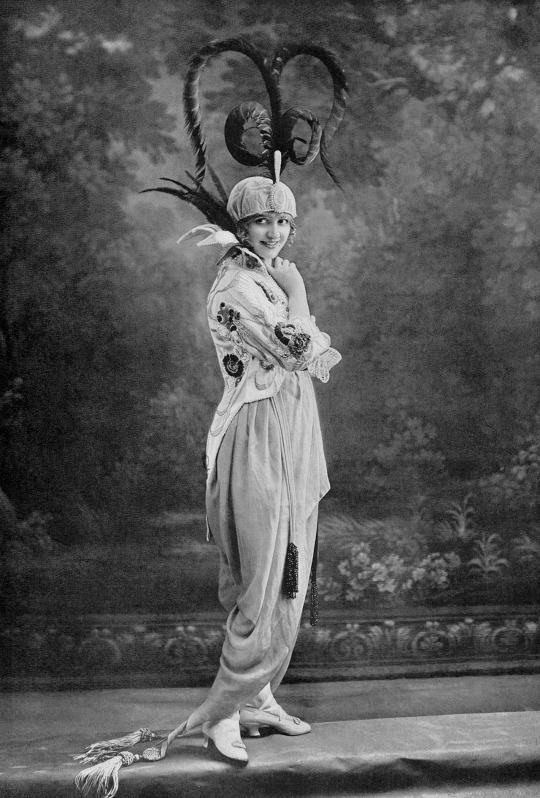

1913 Dress worn by comtesse Greffulhe (Palais Galliera, Musee de la mode de la Ville de Paris - Paris France) photo - Pierre Bulloz. From twonerdyhistorygirls.blogspot.com/2016/12/the-extraordinary-style-of-countess.

1913 Anna de Noailles La condesa Anna de Noailles by Ignacio Zuloaga (Museo de Bellas Artes de Bilbao - Bilbao Spain). From tumblr.com/random-brushstrokes 1398X1080.
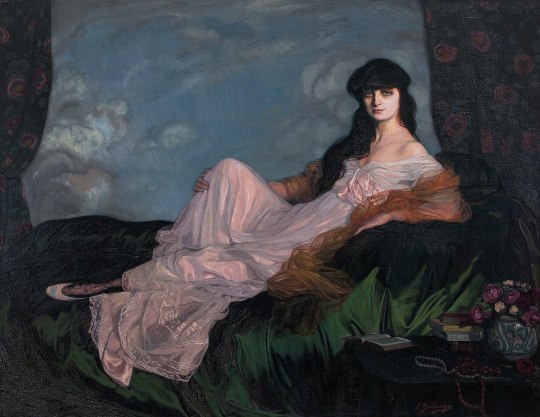
Left 1913 Baroness de Guestre before bas relief sculpture. From the Library of Congress Bain collection 550X899.
Center 1913 Baroness de Guestre climbing stairs (Library of Congress Bain collection). From Wikimedia 1878X2048.
Right 1913 Baroness de Guestre in the garden. From the Library of Congress Bain collection via flickr 553X912.



#1913 fashion#1910s fashion#Belle Époque fashion#Edwardian fashion#Juliette Rudy#Buzenet#Christoph Drecoll#Jeanne Lanvin#Gustave Beer#Antoine and Hubert#Armand Vallée#Talbot photo#Gaby Deslys#Anna de Noailles#Ignacio Zuloaga#Baroness de Guestre#comtesse Greffulhe#Pierre Bulloz#Paquin#Geneviève Lantelme
4 notes
·
View notes
Text

have you seen EMMANUELLE GENEVIEVE MARIE DE ROHAN DE NOAILLES?. we’ve heard through the grapevine that they’re DYNAMIC but also NONCOMFORMIST. i heard that HER main objective this season is GET TO KNOW ENGLAND AND LIVE THE ENGLISH SEASON TO ITS FULLEST.
STATISTICS
full name : emmanuelle généviève marie de rohan.
meaning : emmanuelle means god is with us, généviève means white wave and marie means sea of bitterness.
nicknames : jeanie, gen, viv, madame deuil.
occupation : noblewoman, aristocrat, salonniere.
noble titles : duchess dowager of noailles, mademoiselle de rohan.
title of reference : her grace.
gender + pronouns : ciswoman, she / her.
orientation : bisexual biromantic.
age : thirty.
BACKGROUND
date of birth : tba, 1781.
place of birth : paris, france.
rank : high nobility.
father : charles gabriel de rohan, duke of montbazon and prince of guemene, controller - general of finances of france.
mother : victoire emmanuelle de rohan, former lady in waiting to the queen of france.
siblings : two brothers and one sister, all older.
spouse : henri philippe de noailles, duke of noailles.
offspring : henri victor de noailles, duke of noailles ( 9 years old ); anaïs victoire de noailles, lady of noailles ( 5 years old ).
other : charles edoard de rohan, cardinal de rohan and french ambassador to vienna; paternal uncle.
relationship status : widowed.
languages : french, german, italian, english.
APPEARANCE
faceclaim : greta onieogou
height : 173cm / 5'8''
hair: tba
eye: big brown eyes.
HISTORY
trigger warning for parental death, arranged marriage, chronical illness (haemophilia), spousal death.
the house of rohan has dominated the french court for at least two centuries, with positions being passed down from father to son, mother to daughter; those spanned from the positions in church, to the court, to politics. it was no different to edoard, cardinal de rohan and one of the most important ambassadors of the kingdom, nor gabriel, who grew to hold the position of minister of finances for at least twenty years now.
emmanuelle genevieve is born akin to an accident, barely a year after the brother she’s closest in age to; a manner she would follow for the rest of her life. the succession of births demean the constitution of lady rohan, victoire, and it would not be two years, with the youngest still toddling, that her mother would come to pass.
genevieve, as preferred, is then raised with all of the coddling expected for the youngest child. she’s spoiled rotten, quite literally, without a soul able to tell her no — she thrives on the few forbidden, forward things, riding horses until she’s sore and muddy, staying up late playing cards, drinking and talking about everything and anything, spending more than she should and dabbling in conversations she should not. she takes part in all that the court has to offer, and a few things more — the dancing, the arts, the fashion, the phylosophy and all of that.
she goes to vienna with her uncle, once. she had pleaded, for as long as she could remember, to accompany the man on a trip, and he finally yields, finding that this may broaden her experiences and her marriage possibilities. instead, genevieve returns home with a small bump hidden beneath her corset, and a big trouble; refusing to announce the father of the babe she carried — for truth to the matter, she did not know — her family despaired, behind closed doors, on what to do so she may not fall into disgrace.
they come into accord, more or less willing, to have her marry someone else: the count of novailles had a sprouting career as a diplomat, and was the second child of an important house, and had always had obvious affection towards genevieve; she thought him a dreadful bore, but without much choice, she wedded him, and named her son after him. if henri has ever doubted her, he has kept his assumptions to himself.
it is not entirely pleasant. though — rather, odd. despite apparent affection, henri refuses to partake in his husband duties, and what genevieve once appreciated, finding that she’s not one for the birthing bed and childrearing, soon becomes puzzling. her freedoms are not diminished, however, so she bites her tongue, until the truth is revealed when her brother - in - law goes on a campaign, and bleeds himself to death in an alarming fashion. her husband becomes duke, and she duchess, but henri has to reveal his family has a sickness that plagues its men, leaving them wary of every injury; he’s on a sort of concoction, but it drives him away from the marriage bed.
the confession ushers them closer, and genevieve sees that he dismisses his medicine so they may become one, at last. for several months, it seems they are closer than ever, and become quite a scene at court. before she can announce herself with child, the king orders a hunt, and, as ever, wishing to please her, henri goes along. a mere fall would not have killed a healthy man, who would have shrugged it off and laughed before mounting again, but henri was not a healthy man, and they remain a scene to the end, with genevieve jumping from her horse to cradle her husband’s dying body until she is dragged away.
she gives birth some months later, after being stuck on bed rest since her husband’s death. love she had not known had sprung, and died with him, and for the respectable amount of time, she remains at her husband’s — now her son’s — states, away from court. still, she begins welcoming artists, writers, actors, people of the arts to amuse her, and her inner circle, that grows, bit by bit. the salon of madame de noailles would become one of the few that one must attend while in paris, and genevieve slowly returns to her bon vivant self, a staple within the high society.
while genevieve is skeptical that the english can hold a candle to the magnificence of the french scene, she has always been curious about the season. and so, she has come along with the royal family, hoping to enjoy all that is available.
PERSONALITY
tba
WANTED CONNECTIONS
the typical sort: friends, lovers, enemies, acquaintances, etc, but also people she’s sponsored, people who consider her a bad influence, more to add once my brain works!
1 note
·
View note
Note
I believe it is time I tell you about my recent OC outbusrt, here is a list, choose however you will-
- Raichō Hiratsuka
- C. S. Lewis
- Charlotte Brontë
- Louise Compain
- Nina (de Callias) Compain
- Maurice Clavel
- Maurice Leblanc
- Ophélie Compain
- George Sand
- Émile Zola
- Antoine de Saint-Exupéry
- Victor Hugo
- William Shakespeare
- Goethe
- Alexandre Dumas
- Lord Byron
- Mary Shelley
- Anna de Noailles
- Arthur Conan Doyle
- Marina Tsvetaïeva
- Pierre de Ronsard
- Ann Petry
- Ernest Hemingway
- Susan Hill
- Mo Yan
- Roald Dahl
- Dorothy Wilde
- Stéphane Mallarmé
- John Keats
- Sylvia Plath
- Émilie Evershed
- Charles Dickens
- Jonathan Swift
- Walt Whitman
- Alexandre Blok
- Mikhaïl Lermontov
- Sophia Parnok
- Anton Tchekhov
(also yes they have the same name as authors because that's the thing of the serie, the characters are based of authors, name, power, personnality, etc)
OOOOOOH THIS LOOKS SICK
I’d like to order infodumps on CS Lewis, Shakespeare, Antoine, and Doyle please 😌♥️
1 note
·
View note
Text

Man Ray (Emmanuel Radnitzky) :: Bal au château des Noailles, vers 1929. Epreuve gélatino-argentique. | src l'œil de la photographie
view more on wordPress
#Man Ray#bal constumé#bal constume#ball costume#surrealism#role portrait#chateau de noailles#costume#costume portrait#disguise#Emmanuel Radnitzky#mesh net#portrait#Porträt#retrato#ritratto#portret#charles de noailles#retrat#Bildnis#marie laure de noailles#rollenportrat#surrealisme#1920s
118 notes
·
View notes
Quote
From Vicente Huidobro
Paris, 20 May 1931
Mr don Luis Buñuel,
First of all, speaking of shit, we are now I believe in a mutual shitstorm.
So now, with regard to the alleged attacks you claim I have made on Surrealism, I declare that:
1) I am not disputing those accusations to ingratiate myself with the Surrealists, nor because I feel myself compelled to sing their praises, but in order to honour the truth. I do not believe in intangible sects (and am certainly not afraid of them). I do believe in one or another man from a group, but not in the group as a whole.
Moreover, remembering that you felt you had the right to attack the Surrealists as you did in the days of your friendship with Zervos, what can you possibly say to me now for doing the same thing?
2) It may well be when you and Dalí were at the Dôme, I attacked certain acts, certain individuals and certain ideas of Surrealism – particularly its painting – but not the movement itself, as it has many of the characteristics I have always defended, particularly its vital opposition to the usual conventions. If I am not mistaken, Tzara was there and he supported my position. Hela Hein was also with us.
3) I said, and I reiterate this here, because it is the truth, that when we wrote a poem each of us a line at a time, with Éluard, at my house, 41 Rue Victor Massé, I wrote the first line. This poem still exists, with Éluard’s lines in his own hand. I would not have said this to attack Éluard, as I have always enjoyed much of his work (and have said as much whenever I have had occasion to write about him). I knew him and was his friend when you were still eulogizing García Lorca, before you set foot in Paris. What is more, had I criticized him, it would still mean nothing, because Breton, such a close friend of Éluard’s, suggested when discussing the poets of that group that Desnos and Péret were the most interesting and far superior to Éluard (as I am sure you know, Éluard and Péret’s poetry was, in essence, exactly the same for Dada as for Surrealism. That much is perfectly clear).
4) I have never attacked Breton personally, as he has always seemed to me one of the worthiest of contemporary writers, and one I have often defended, even against people who are now his friends, both when he wrote Le Coeur à barbe and previously. Tzara could tell you something about those discussions, which took place only two years ago, or a little longer. This does not mean that I feel obliged to find all Breton’s work perfect, nor he himself sacrosanct.
5) Nor is it true that I claimed the Surrealists invited me to join their group and offered to publicize my work. I remember exactly what I said. I said that in the early days the Surrealists opened an office to promote their ideas, and that on one occasion when I was there, they said I was always welcome and Breton gave me one of his books with a very gracious dedication (a book I still possess). I then added that whenever a new school is born it presents the rest of us with the choice to join in and count on the support of the whole group or remain apart and risk being considered hostile or indifferent. That is what I said, and I repeat it now, although I was referring principally, I’m sure, to Le Coeur à barbe and Dada, because cubism and Creacionismo are the only groups I have ever been involved in, albeit always retaining my own independence.
6) I have not attacked Freud (you refer to everything as an attack); what I said was that Freud saw the sexual complex behind every phenomenon and that I considered the death complex to be just as important to the life of mankind; just as important, if not more important, than the sexual complex. This I reiterate now. And do not think that I am making excuses for myself, for I do not believe Freud or anyone else, to be inviolable.
Have no fear that I will hide your letter away and only produce my own; that is not in my nature. When I do show mine, I will also show yours, and I only hope we’ll soon find a way of publishing them together.
As regards the term ‘failed artist’, you may be correct; indeed, this may be my only source of pretension. I do believe that only two or three of my close companions are fully able to enjoy my poetry, but the curious thing is that, instead of making me sad, this is in fact a source of happiness that consoles me for the success of some of my other books, especially those that I had to write to make a living. Only success makes me doubt myself, as it makes me doubt all other men. And we shall never see eye to eye, because I believe the opposite is true for you: you are interested only in success and seek only success. This is precisely what makes me doubt you. I join Rimbaud and Lautréamont in my failure, and they are fine company. They were the great failures of their time, whilst the celebrated poet, who graced the salons patronized by the Viscounts and Viscountesses de Noailles of the day, was one Rollinat, whom no one now remembers. I am quite sure that the Rimbauds and the Lautréamonts will always be the great and unknown failures of their day. And that this will always be the case.
With regard to my inferiority complex, you are again mistaken. For any true initiate in psychoanalysis, the first symptom of inferiority is demonstrated by the need to belong and an inability to stand alone, a need to take refuge in groups, to feel sick, weak and meagre when not shoulder-to-shoulder with the rest. Rimbaud and Lautréamont, whom the surrealists quite rightly so much admire, were not members of a group, they were, on the contrary, solitary souls, not drawn to the herd or to the squad. An ‘inferiority complex’ consists precisely in suffering the vertigo of loneliness. One finds it in those men of effeminate character, so abundant in this beautiful city of Paris, men who cannot take a single step without leaning on and being supported by others. This is what is known as making a strength of many weaknesses.
I now consider this matter to be at an end and have just two things to add. Your words and your actions reveal you to be a clinical case of the succubus and prototype of the Catholic who, having abandoned his religion, has to follow other idols and submit himself absolutely to another Pope. I have no such idolatry, nor do I believe in infallible sects (if you could only know how well I feel), nor do I need to consult anyone in order to reply to you. I respond by and for myself.
It is not my place to speak of Cossío and Castanyer. I shall forward your letter to them.
[Vicente Huidobro]
Jo Evans & Breixo Viejo, Luis Buñuel: A Life in Letters
#jo evans#breixo viejo#luis bunuel: a life in letters#vicente huidobro#luis bunuel#sigmund freud#charles de noailles
0 notes
Text
The Marriage of Adrienne and Gilbert
I wish I could say that some short time ago, @northernmariette and I had a bit of talk about the marriage of the La Fayette’s and that I promptly got to work writing the post they had suggested … well, our discussion has been some long time ago but I finally have the post ready. :-)
Let me preface this entry by saying that the match between Adrienne and Gilbert was a match made in heaven. Not only did the two of them develop feelings for each other and ultimately had a loving, affectionate and mostly happy relationship, their marriage also accomplished everything that an arranged marriage could hope to accomplish. Arranged marriages at that time and in their social classes were usually made between a rich family that lacked a grand name and a family that had lost their fortune but still possessed their great name. In the case of the Noailles’s and the La Fayette’s both families had both money and titles. La Fayette was maybe a tad richer than his future in-laws, the Noailles’, the Noailles’ therefor had a better standing at court. Still, all in all it was match of equal footing.
La Fayette had been orphaned at a young age and was now more or less chaperoned by some of his aunts and uncles and grandparents. The duc d’Ayen, Adrienne’s father, only had daughters that lived into adulthood – and he was not necessarily pleased by that. His oldest daughter Louise was married to her cousin, Louis, the vicomte de Noailles, so that the name would stay in the family. Now it was time to find suitable husbands for his other daughters. La Fayette seemed like a perfect candidate for the next oldest daughter, Adrienne. He came from a prominent family, was rich, had the title of Marquis, was close in age to Adrienne and his guardians were subtly looking around for a suitable wife as well.
We were scarcely twelve years old when M de Lafayette was proposed to her [Adrienne’s mother] for one of us [Adrienne or her older sister Louise]; he himself was only fourteen. His extreme youth, no parents to guide him, having lost all his near relations and having no one in whom he could repose confidence, a large fortune already in his possession, which my mother looked upon as a dangerous gift, all these considerations made her at first refuse him, notwithstanding the good opinion she had acquired of his personal qualities.
Mme de Lasteyrie, Life of Madame de Lafayette, L. Techener, London, 1872, p. 34-35.
Adrienne’s mother, the duchess d’Ayen, was not at all happy about the recent developments at the marriage-front. The thought of having to part with her beloved children was hard another on its own, but by the time that the marriage between Adrienne and La Fayette was proposed, Adrienne had just turned twelve, La Fayette was fourteen. She protested vehemently. Adrienne was not a woman, just a little girl and neither bride nor groom had finished their education yet. Although the duchess was normally an obedient and dutiful wife, she could also be extremely headstrong when she believed herself to be in the right.
Other cares also occupied my mother’s mind during these years. It was at that time that she first received proposals of marriage for her two eldest daughters. Although these proposals were rather premature, my mother, long before they had been made, every time the thought of having to give us to another crossed her mind, was unable to conquer the anguish of her heart. But she never allowed herself to be guided by first impressions and by worldly considerations alone. In such circumstances she would throw herself into the arms of God and await his will with patient courage. (…) It was with this belief that she listened to the first proposals of marriage for her daughters.
Mme de Lasteyrie, Life of Madame de Lafayette, L. Techener, London, 1872, p. 32-34.
Half of fashionable Paris was soon discussing the opposition that the duc faced from his wife. In the end, the duchess prevailed and the duc had to relent, a bargain was made. The duc would negotiate the marriage with La Fayette’s uncle but the marriage would not take place for another two years. During these two years, the duchess would further Adrienne’s education and prepare her for her new role, the duc would personally see to La Fayette’s education and bride and groom would find the time to get to know each other. After the marriage, they would continue to live with the de Noailles’ in their home.
She persisted several months in her refusal; but my father was not discouraged, and as one of his friends observed to him that my mother had gone too far ever to change her mind, he did justice to her straightforwardness in the midst of his anger against her. “You do not know Mme. d Ayen, he said, however far she may have gone, you will see that she will give way like a child if you prove to her that she is in the wrong; but on the other hand she will never yield if she her mistake.” Accordingly, when she was told that her daughter would not leave her during the first years of her marriage, and that it would only be celebrated at the end of two years, several measures having been taken to finish M. de Lafayette’s education, she accepted him whom she cherished ever after as the most tenderly beloved son, whom she valued from the first moment she became acquainted with him, and who alone could have sustained the strength of my heart after having lost her.
Mme de Lasteyrie, Life of Madame de Lafayette, L. Techener, London, 1872, p. 35-36.
The negotiations proofed … tense at time but in the end, the duc d’Ayen agreed to pay a dowry of 200.000 Livre (converting this sum into a more modern equivalent is a bit difficult but we are talking in the dimension of roughly two Million USD). La Fayette was transferred into the regiment of dragoons, Les Dragons de Noailles, and in February of 1773 by the age of fifteen he had moved in with his future-in-laws and lived with them when he was not away on military duty. Important point here is that neither La Fayette nor Adrienne had been told what was going on. Fashionable Paris was maybe talking about one of the matches of the social season, but bride and groom remained oblivious for now.
My sister [Louise] and I had witnessed the misunderstanding between our parents, but we were in ignorance of its cause which my father would have ever kept from my knowledge, but which was afterwards told me by my mother who was convinced that I could only feel grateful towards those who had prepared my happiness with such unworldly views. (…) The two marriages [Louise’s and Adrienne’s] were therefore decided, on condition that nothing would be said to my sister before a year and to me before eighteen months. It was settled that M. de Noailles and M. de Lafayette should meet us sometimes either at home or out walking, but my mother wished that our minds should not be distracted that year from our education, as we were going to be married so young.
Mme de Lasteyrie, Life of Madame de Lafayette, L. Techener, London, 1872, p. 36-38.
The two of them were eventually told about the arrangements, La Fayette a bit earlier than Adrienne. We have Adrienne’s account of her initial reaction:
It was at that time that I was spoken to of M. de Lafayette towards whom I was already attracted by feelings forerunners of that deep and tender affection which every day has united us more and more in the midst of all the vicissitudes of this life, in the midst of the blessings and misfortunes which have filled it for the last twenty-four years. With what pleasure I learnt that, for more than a year, my mother had looked upon him and loved him as a son! She told me all the good she had heard with regard to him all she thought of him herself, and I saw that he already felt for her that filial affection which was to be the blessing of my life. She tried to calm down my poor weak brain which was overexcited by the importance of the coming event. She taught me to pray, she prayed herself for the blessings of Heaven on my future condition. As I had the happiness of remaining with her, my only feelings were those of deep emotion.
Mme de Lasteyrie, Life of Madame de Lafayette, L. Techener, London, 1872, p. 39-41.
Adrienne and La Fayette married on April 11, 1774, in Paris in the chapel of the Hôtel de Noailles. The bride was “fourteen and a half”, the groom sixteen. The archbishop of Paris officiated the wedding and forty guests were witnesses. 31 of these guests belonged to Adrienne’s family and only nine to La Fayette’s side. Since La Fayette in particular was a member of the Noblesse de la robe, the King had to give his consent. King Louis XV signed the marriage contact as well as the future Louis XVI, Louis XVIII and Charles X. La Fayette had learned riding with all three of these future French kings (and would struggle to get along with them as time went on.)
In contrast to the ceremony itself, the following reception was lavish. I can not give you an exact number of guests, but I have the menu and that alone might serve as an indicator for the scale of the festivities.

Harlow Giles Unger, Lafayette, John Wiley & Sons, Inc., 2002, p. 13.
La Fayette himself was gifted a captaincy in his regiment (the regiment that his father-in-law owned) as soon as he would turn eighteen.
We have the first page of the couples Contrat de Mariage, written by the notary Ladequive in 1773:

Contrat de Mariage de Monsieur Le Marquis de La Fayette Avec Mademoiselle de Noailles, Passé devant Laidequive, Notaire, 1773.
Cleveland State University Library Special Collections, the Marquis de Lafayette Collection. (10/19/2022)
We also have the Articles de Mariage that were drawn up during the negotiations in October of 1772 and primarily discussed financial matter like Adrienne’s dowry:

The Arthur H. and Mary Marden Dean Lafayette Collection, 1520-1849, Collection 4991, box 10, folder 44, Digital Facsimiles: Family and Private Life. (10/19/2022)
#marquis de lafayette#la fayette#french history#american history#history#northernmariette#adrienne de noailles#adrienne de lafayette#1772#1773#1774#louis xv#louis xvi#louis xviii#charles x#le duc d'ayen#vicomte de noailles#louise de noailles#harlow giles unger
49 notes
·
View notes
Photo





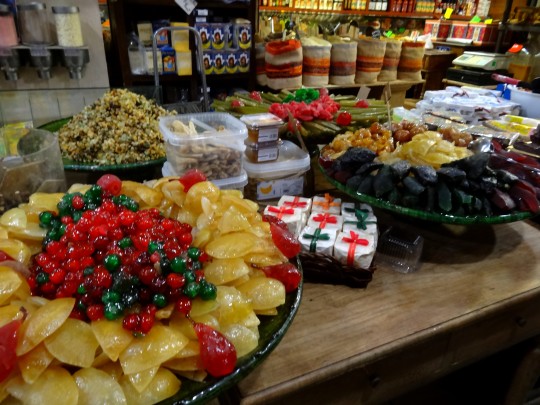


Je reviens ENCORE une fois à mon projet de présenter la plupart de mes 55800 photos (environ). On est en 2017 et comme ce blog est né en 2017, j’arriverai donc au bout de cette présentation.
Marseille, au printemps.
- le port de la Joliette, vue des bien-nommées ‘Terrasses du Port”
- Sous la Cathédrale de la Major, une fontaine aux dauphins
- les deux suivantes : deux atriums des Docks
- la Gare Saint-Charles
- à Noailles, dans la Rue Longue des Capucins, le magasin “Saladin”
- Rue Bussy-l’Indien
- Rue Pastoret
#souvenir#marseille#port de la joliette#la joliette#terrasses du port#port#la major#cathédrale de la major#fontaine#les docks#palmier#gare saint-charles#saint-charles#noailles#tag#art urbain#graffiti#rue longue des capucins#saladin#couleur#rue-longue-des-capucins#ours#rue pastoret#jaune#rue bussy-l'indien#atrium
2 notes
·
View notes
Text
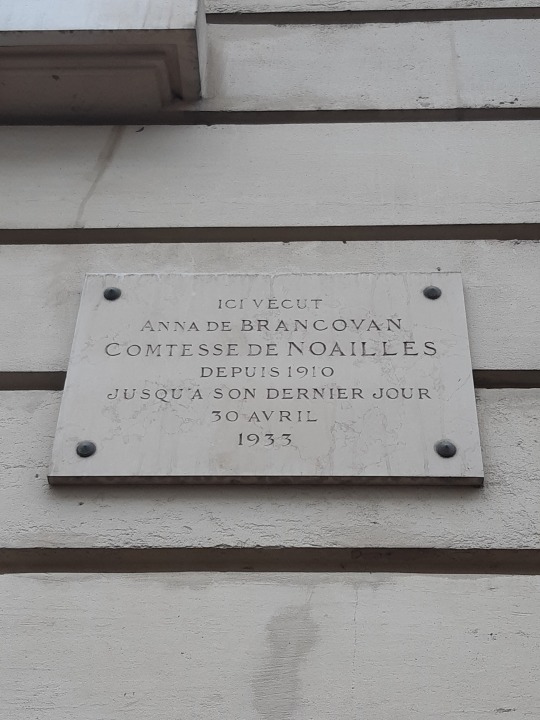

Plaque en hommage à : Anna de Noailles
Type : Lieu de résidence
Adresse : 40 rue Scheffer, 75016 Paris, France
Date de pose :
Texte : Ici vécut Anna de Brancovan, comtesse de Noailles, depuis 1910 jusqu'à son dernier jour, 30 avril 1933
Quelques précisions : Anna de Noailles (1876-1933) est une poétesse française d'origine gréco-roumaine. Issue de la noblesse roumaine, elle a accès à une éducation de qualité, qui la forment à l'art, à la poésie et à plusieurs langues étrangères. Dès le début des années 1900 et jusqu'à sa mort, elle publie de nombreux recueils de poèmes, comme Le Cœur innombrable. Elle contribue également à la création du prix littéraire Vie heureuse (qui deviendra plus tard le prix Femina). En 1909, elle fut toutefois au centre d'une controverse qui la rend responsable du suicide de l'écrivain Charles Demange, qui était amoureux d'elle. Elle se fait connaître dans le milieu littéraire parisien en fréquentant des salons ou en tenant son propre salon, fréquentant des intellectuels comme Paul Valéry, Jean Paulhan ou Paul Claudel et entretenant une forte amitié épistolaire avec Marcel Proust. Un square de Paris porte son nom, et une autre plaque commémorative en son honneur peut être trouvée dans le septième arrondissement de Paris.
1 note
·
View note